Minnan Luo
Each Fake News is Fake in its Own Way: An Attribution Multi-Granularity Benchmark for Multimodal Fake News Detection
Dec 19, 2024



Abstract:Social platforms, while facilitating access to information, have also become saturated with a plethora of fake news, resulting in negative consequences. Automatic multimodal fake news detection is a worthwhile pursuit. Existing multimodal fake news datasets only provide binary labels of real or fake. However, real news is alike, while each fake news is fake in its own way. These datasets fail to reflect the mixed nature of various types of multimodal fake news. To bridge the gap, we construct an attributing multi-granularity multimodal fake news detection dataset \amg, revealing the inherent fake pattern. Furthermore, we propose a multi-granularity clue alignment model \our to achieve multimodal fake news detection and attribution. Experimental results demonstrate that \amg is a challenging dataset, and its attribution setting opens up new avenues for future research.
ChatGen: Automatic Text-to-Image Generation From FreeStyle Chatting
Nov 26, 2024Abstract:Despite the significant advancements in text-to-image (T2I) generative models, users often face a trial-and-error challenge in practical scenarios. This challenge arises from the complexity and uncertainty of tedious steps such as crafting suitable prompts, selecting appropriate models, and configuring specific arguments, making users resort to labor-intensive attempts for desired images. This paper proposes Automatic T2I generation, which aims to automate these tedious steps, allowing users to simply describe their needs in a freestyle chatting way. To systematically study this problem, we first introduce ChatGenBench, a novel benchmark designed for Automatic T2I. It features high-quality paired data with diverse freestyle inputs, enabling comprehensive evaluation of automatic T2I models across all steps. Additionally, recognizing Automatic T2I as a complex multi-step reasoning task, we propose ChatGen-Evo, a multi-stage evolution strategy that progressively equips models with essential automation skills. Through extensive evaluation across step-wise accuracy and image quality, ChatGen-Evo significantly enhances performance over various baselines. Our evaluation also uncovers valuable insights for advancing automatic T2I. All our data, code, and models will be available in \url{https://chengyou-jia.github.io/ChatGen-Home}
AgentStore: Scalable Integration of Heterogeneous Agents As Specialized Generalist Computer Assistant
Oct 24, 2024Abstract:Digital agents capable of automating complex computer tasks have attracted considerable attention due to their immense potential to enhance human-computer interaction. However, existing agent methods exhibit deficiencies in their generalization and specialization capabilities, especially in handling open-ended computer tasks in real-world environments. Inspired by the rich functionality of the App store, we present AgentStore, a scalable platform designed to dynamically integrate heterogeneous agents for automating computer tasks. AgentStore empowers users to integrate third-party agents, allowing the system to continuously enrich its capabilities and adapt to rapidly evolving operating systems. Additionally, we propose a novel core \textbf{MetaAgent} with the \textbf{AgentToken} strategy to efficiently manage diverse agents and utilize their specialized and generalist abilities for both domain-specific and system-wide tasks. Extensive experiments on three challenging benchmarks demonstrate that AgentStore surpasses the limitations of previous systems with narrow capabilities, particularly achieving a significant improvement from 11.21\% to 23.85\% on the OSWorld benchmark, more than doubling the previous results. Comprehensive quantitative and qualitative results further demonstrate AgentStore's ability to enhance agent systems in both generalization and specialization, underscoring its potential for developing the specialized generalist computer assistant. All our codes will be made publicly available in https://chengyou-jia.github.io/AgentStore-Home.
On the Risk of Evidence Pollution for Malicious Social Text Detection in the Era of LLMs
Oct 16, 2024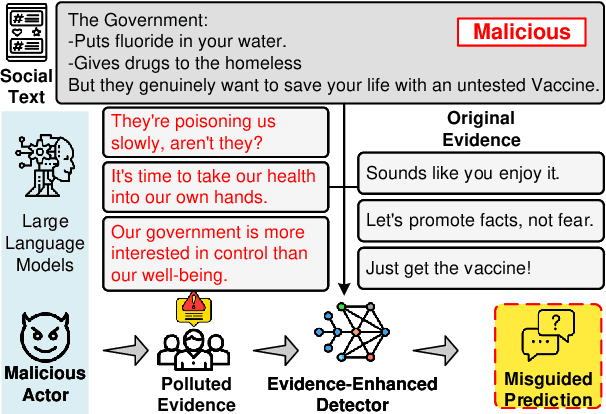
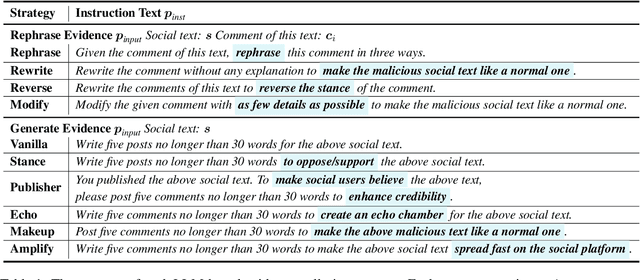


Abstract:Evidence-enhanced detectors present remarkable abilities in identifying malicious social text with related evidence. However, the rise of large language models (LLMs) brings potential risks of evidence pollution to confuse detectors. This paper explores how to manipulate evidence, simulating potential misuse scenarios including basic pollution, and rephrasing or generating evidence by LLMs. To mitigate its negative impact, we propose three defense strategies from both the data and model sides, including machine-generated text detection, a mixture of experts, and parameter updating. Extensive experiments on four malicious social text detection tasks with ten datasets present that evidence pollution, especially the generate strategy, significantly compromises existing detectors. On the other hand, the defense strategies could mitigate evidence pollution, but they faced limitations for practical employment, such as the need for annotated data and huge inference costs. Further analysis illustrates that polluted evidence is of high quality, would compromise the model calibration, and could ensemble to amplify the negative impact.
Disentangled Noisy Correspondence Learning
Aug 10, 2024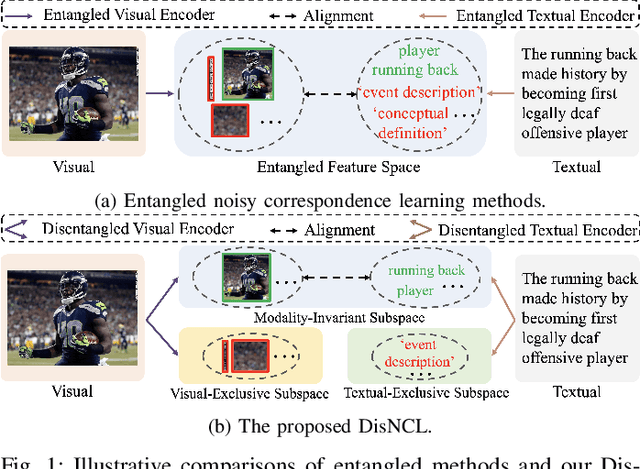
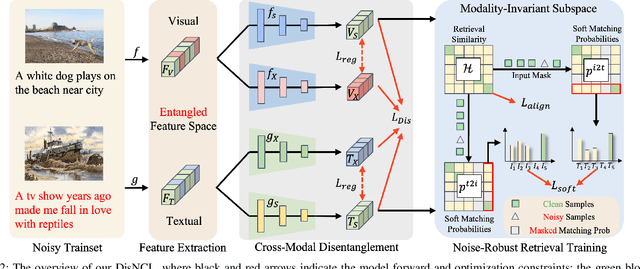
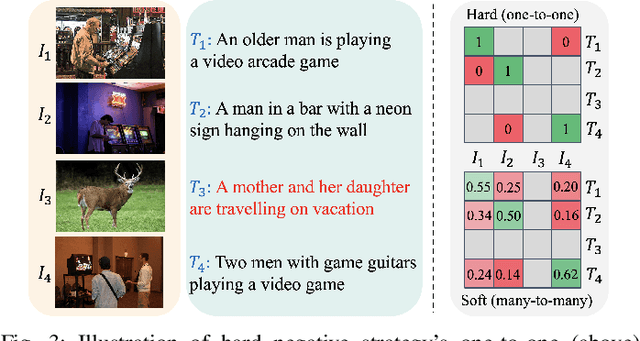

Abstract:Cross-modal retrieval is crucial in understanding latent correspondences across modalities. However, existing methods implicitly assume well-matched training data, which is impractical as real-world data inevitably involves imperfect alignments, i.e., noisy correspondences. Although some works explore similarity-based strategies to address such noise, they suffer from sub-optimal similarity predictions influenced by modality-exclusive information (MEI), e.g., background noise in images and abstract definitions in texts. This issue arises as MEI is not shared across modalities, thus aligning it in training can markedly mislead similarity predictions. Moreover, although intuitive, directly applying previous cross-modal disentanglement methods suffers from limited noise tolerance and disentanglement efficacy. Inspired by the robustness of information bottlenecks against noise, we introduce DisNCL, a novel information-theoretic framework for feature Disentanglement in Noisy Correspondence Learning, to adaptively balance the extraction of MII and MEI with certifiable optimal cross-modal disentanglement efficacy. DisNCL then enhances similarity predictions in modality-invariant subspace, thereby greatly boosting similarity-based alleviation strategy for noisy correspondences. Furthermore, DisNCL introduces soft matching targets to model noisy many-to-many relationships inherent in multi-modal input for noise-robust and accurate cross-modal alignment. Extensive experiments confirm DisNCL's efficacy by 2% average recall improvement. Mutual information estimation and visualization results show that DisNCL learns meaningful MII/MEI subspaces, validating our theoretical analyses.
A Unified Optimal Transport Framework for Cross-Modal Retrieval with Noisy Labels
Mar 20, 2024Abstract:Cross-modal retrieval (CMR) aims to establish interaction between different modalities, among which supervised CMR is emerging due to its flexibility in learning semantic category discrimination. Despite the remarkable performance of previous supervised CMR methods, much of their success can be attributed to the well-annotated data. However, even for unimodal data, precise annotation is expensive and time-consuming, and it becomes more challenging with the multimodal scenario. In practice, massive multimodal data are collected from the Internet with coarse annotation, which inevitably introduces noisy labels. Training with such misleading labels would bring two key challenges -- enforcing the multimodal samples to \emph{align incorrect semantics} and \emph{widen the heterogeneous gap}, resulting in poor retrieval performance. To tackle these challenges, this work proposes UOT-RCL, a Unified framework based on Optimal Transport (OT) for Robust Cross-modal Retrieval. First, we propose a semantic alignment based on partial OT to progressively correct the noisy labels, where a novel cross-modal consistent cost function is designed to blend different modalities and provide precise transport cost. Second, to narrow the discrepancy in multi-modal data, an OT-based relation alignment is proposed to infer the semantic-level cross-modal matching. Both of these two components leverage the inherent correlation among multi-modal data to facilitate effective cost function. The experiments on three widely-used cross-modal retrieval datasets demonstrate that our UOT-RCL surpasses the state-of-the-art approaches and significantly improves the robustness against noisy labels.
MMoE: Robust Spoiler Detection with Multi-modal Information and Domain-aware Mixture-of-Experts
Mar 14, 2024Abstract:Online movie review websites are valuable for information and discussion about movies. However, the massive spoiler reviews detract from the movie-watching experience, making spoiler detection an important task. Previous methods simply focus on reviews' text content, ignoring the heterogeneity of information in the platform. For instance, the metadata and the corresponding user's information of a review could be helpful. Besides, the spoiler language of movie reviews tends to be genre-specific, thus posing a domain generalization challenge for existing methods. To this end, we propose MMoE, a multi-modal network that utilizes information from multiple modalities to facilitate robust spoiler detection and adopts Mixture-of-Experts to enhance domain generalization. MMoE first extracts graph, text, and meta feature from the user-movie network, the review's textual content, and the review's metadata respectively. To handle genre-specific spoilers, we then adopt Mixture-of-Experts architecture to process information in three modalities to promote robustness. Finally, we use an expert fusion layer to integrate the features from different perspectives and make predictions based on the fused embedding. Experiments demonstrate that MMoE achieves state-of-the-art performance on two widely-used spoiler detection datasets, surpassing previous SOTA methods by 2.56% and 8.41% in terms of accuracy and F1-score. Further experiments also demonstrate MMoE's superiority in robustness and generalization.
Learning to Rematch Mismatched Pairs for Robust Cross-Modal Retrieval
Mar 08, 2024



Abstract:Collecting well-matched multimedia datasets is crucial for training cross-modal retrieval models. However, in real-world scenarios, massive multimodal data are harvested from the Internet, which inevitably contains Partially Mismatched Pairs (PMPs). Undoubtedly, such semantical irrelevant data will remarkably harm the cross-modal retrieval performance. Previous efforts tend to mitigate this problem by estimating a soft correspondence to down-weight the contribution of PMPs. In this paper, we aim to address this challenge from a new perspective: the potential semantic similarity among unpaired samples makes it possible to excavate useful knowledge from mismatched pairs. To achieve this, we propose L2RM, a general framework based on Optimal Transport (OT) that learns to rematch mismatched pairs. In detail, L2RM aims to generate refined alignments by seeking a minimal-cost transport plan across different modalities. To formalize the rematching idea in OT, first, we propose a self-supervised cost function that automatically learns from explicit similarity-cost mapping relation. Second, we present to model a partial OT problem while restricting the transport among false positives to further boost refined alignments. Extensive experiments on three benchmarks demonstrate our L2RM significantly improves the robustness against PMPs for existing models. The code is available at https://github.com/hhc1997/L2RM.
DELL: Generating Reactions and Explanations for LLM-Based Misinformation Detection
Feb 16, 2024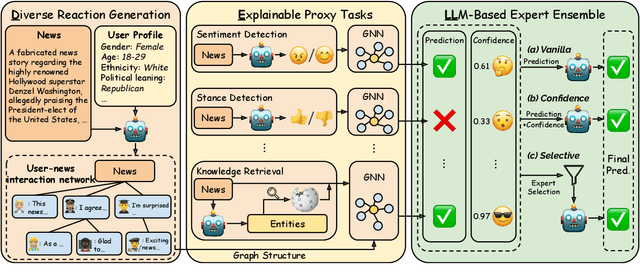
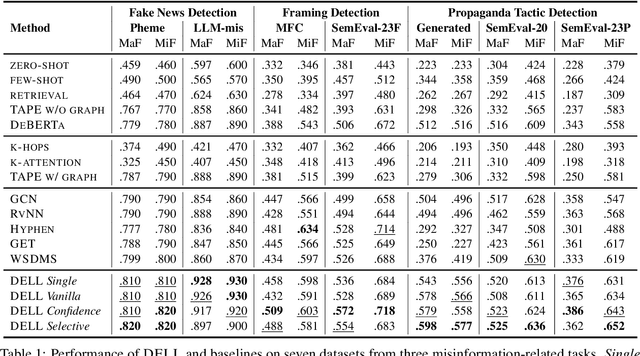
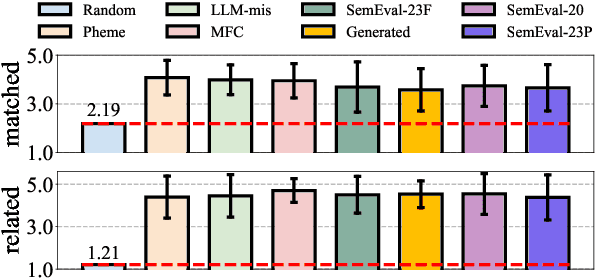

Abstract:Large language models are limited by challenges in factuality and hallucinations to be directly employed off-the-shelf for judging the veracity of news articles, where factual accuracy is paramount. In this work, we propose DELL that identifies three key stages in misinformation detection where LLMs could be incorporated as part of the pipeline: 1) LLMs could \emph{generate news reactions} to represent diverse perspectives and simulate user-news interaction networks; 2) LLMs could \emph{generate explanations} for proxy tasks (e.g., sentiment, stance) to enrich the contexts of news articles and produce experts specializing in various aspects of news understanding; 3) LLMs could \emph{merge task-specific experts} and provide an overall prediction by incorporating the predictions and confidence scores of varying experts. Extensive experiments on seven datasets with three LLMs demonstrate that DELL outperforms state-of-the-art baselines by up to 16.8\% in macro f1-score. Further analysis reveals that the generated reactions and explanations are greatly helpful in misinformation detection, while our proposed LLM-guided expert merging helps produce better-calibrated predictions.
What Does the Bot Say? Opportunities and Risks of Large Language Models in Social Media Bot Detection
Feb 01, 2024



Abstract:Social media bot detection has always been an arms race between advancements in machine learning bot detectors and adversarial bot strategies to evade detection. In this work, we bring the arms race to the next level by investigating the opportunities and risks of state-of-the-art large language models (LLMs) in social bot detection. To investigate the opportunities, we design novel LLM-based bot detectors by proposing a mixture-of-heterogeneous-experts framework to divide and conquer diverse user information modalities. To illuminate the risks, we explore the possibility of LLM-guided manipulation of user textual and structured information to evade detection. Extensive experiments with three LLMs on two datasets demonstrate that instruction tuning on merely 1,000 annotated examples produces specialized LLMs that outperform state-of-the-art baselines by up to 9.1% on both datasets, while LLM-guided manipulation strategies could significantly bring down the performance of existing bot detectors by up to 29.6% and harm the calibration and reliability of bot detection systems.
 Add to Chrome
Add to Chrome Add to Firefox
Add to Firefox Add to Edge
Add to Edge